Following a poor run in which Montpellier HSC picked up just one Ligue 1 win in six games, La Paillade decided to part ways with Romain Piteau.
After just 11 games, the South France club decided to bring back its former boss, Michel Der Zakarian, who had been in charge from May 2017 to May 2021.
Der Zakarian had been in charge of Stade Brest since leaving Montpellier until his dismissal from the Brittany-based outfit back in October.
At the time of writing, the 59-year-old is set to take charge of his first game back in the hot seat at Montpellier this weekend, precisely against his former club, Brest.
Montpellier won Ligue 1 in 2011/12 under René Girard, but after their title victory, they slumped back into being a mid-lower table side.
They achieved their best league finish post-2012 under Der Zakarian in 2018/19, ending sixth in the standings.
The former Montpellier and Armenia defender also guided La Paillade to two consecutive eighth-place finishes the two seasons after that and a 10th-place finish in his first season in charge (2017/18).
In 2016/17, prior to Der Zakarian’s initial arrival, the South France club finished in 15th place.
Under the French-Armenian coach, Montpellier HSC never finished outside the top half of the table during his time at the Stade de la Mosson.
This is a significant achievement as no other coach has managed the club for at least one season and achieved this feat in the last three decades, the last being Henry Kasperczak.
In 1990/91 and 1991/92, the Polish coach led La Paillade to eighth and seventh places, respectively.
Last season, with Olivier Dall’Oglio as the head coach, they finished 13th in Ligue 1.
Der Zakarian now takes charge of a team in 15th place, just two points off the relegation zone.
This weekend, they play a six-point game with Brest, with whom they are level in the table (20 points each).
This tactical analysis aims to highlight some of the main areas in which Montpellier struggled this term, resulting in their participation in a relegation fight.
We’ll also examine some of the most pressing issues Der Zakarian will face immediately upon returning to the club and consider how the 59-year-old may seek to solve those problems.
Montpellier Defensive Struggles
Montpellier have conceded the fourth-most goals (45) of any Ligue 1 side this term.
However, they’ve also allowed the highest amount of expected goals (46.19) in France’s top flight.
Montpellier have conceded 12.31 shots per 90 this term — the fourth-most in the league — and they’ve allowed 0.157 xG per shot — the joint-highest average shot quality conceded in Ligue 1.
These concerning statistics effectively indicate that La Paillade could not prevent their opponents from regularly creating good scoring opportunities.
Michel Der Zakarian Defensive Stats At Montpellier
In Michel Der Zakarian's first tenure at Montpellier, his team generally maintained quite a low xGA.
In 2018/19, they conceded 43.52 xG — the third-lowest in the league — while their 0.103 xGA per shot was the second-lowest in the French top flight.
Meanwhile, in 2019/20, Montpellier conceded 36.41 xG (10th-highest) while conceding 0.106 xG per shot (eighth-lowest).
Michel Der Zakarian Defensive Principles
If we were to describe Der Zakarian in a nutshell, he would be a coach who prioritises defensive organisation and discipline first and foremost.
The French-Armenian is a system-focused coach.
He has no ideals of conventionally beautiful soccer but rather a specific idea of how to get results and make his team greater than the sum of its parts.
Through his system, he believes he can get the most out of his players and the resources available to him.
The 59-year-old’s Montpellier side got less and less aggressive in their pressing throughout his first tenure at the South of France club.
During the 2020/21 season, they had by far the highest PPDA in Ligue 1 at 19.13.
One could argue that the pressing became too passive during this final season.
We wouldn’t expect Der Zakarian to endorse a high-intensity pressing style with many turnovers inside the final third.
We’ll typically find his teams defending a bit deeper and inviting the opposition forward a bit more before deciding to engage.
A Der Zakarian side will defend in the mid-block, engaging at around the halfway line.
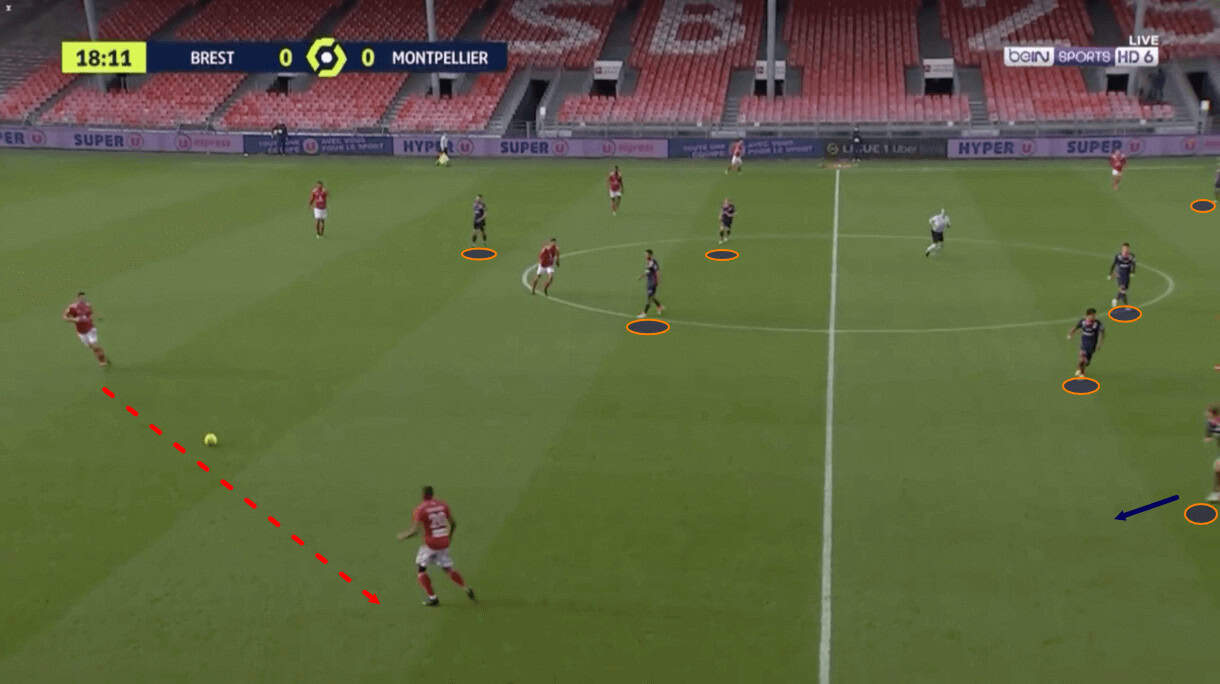
The image above shows an example of this from 2020/21 sea.
The opposition, again ironically Stade Brest, was allowed to play to the halfway line with little-to-no pressure on the backline.
Montpellier’s defensive block shifted backwards, retaining compactness between the lines and discipline to continue protecting their designated zone, not jumping out and sacrificing the defensive system’s solidity.
Each aspect of the defensive block here was key to the system’s success.
One player acting out of control and jumping prematurely could open up space for the opposition to exploit and attack through.
Like the blocks of a Jenga tower, the players must exercise caution when removing themselves from their collective structure, as doing so too aggressively or carelessly can have disastrous consequences for the unit.
They generally prepared to engage at around the halfway line as the opposition entered their half of the pitch.
Ideally, Montpellier would engage on the outside at this point rather than centrally, having hopefully already forced the opposition out into this area via their mid-block structure, which would be challenging to play through centrally.
Montpellier Current Pressing Style
Montpellier's PPDA of 12.23 ranks ninth-highest in Ligue 1 this season.
Under Romain Piteau they have definitely been more aggressive than they were in Der Zakarian’s last season.
They’ve pressed higher and attempted to steal the ball from the opposition backline more often, but they haven’t been incredibly efficient in forcing high turnovers.
At times, they’ve been too easy to play through as a result of this.
For example, in their last game under Piteau, Montpellier put a lot of pressure on Strasbourg's defensive line, but to no avail.
The opponent was constantly comfortable playing the ball out from the back, withstanding the pressure and finding an opportunity to break through Montpellier's pressure beyond midfield.
Due to the forward´s inability to prevent opponents from getting past them and linking up with the forwards, La Paillade's defensive line was constantly under a lot of pressure.
We don’t think Der Zakarian will immediately get close to how passive they were in 2020/21, but we expect Montpellier to be a bit more considered in their pressing.
The new coach will likely emphasise the importance of picking and choosing the moments to press and remaining compact as a unit to maximise the team’s defensive potential.
Montpellier Defensive Territory Map - 2019/20 Vs 2022/23
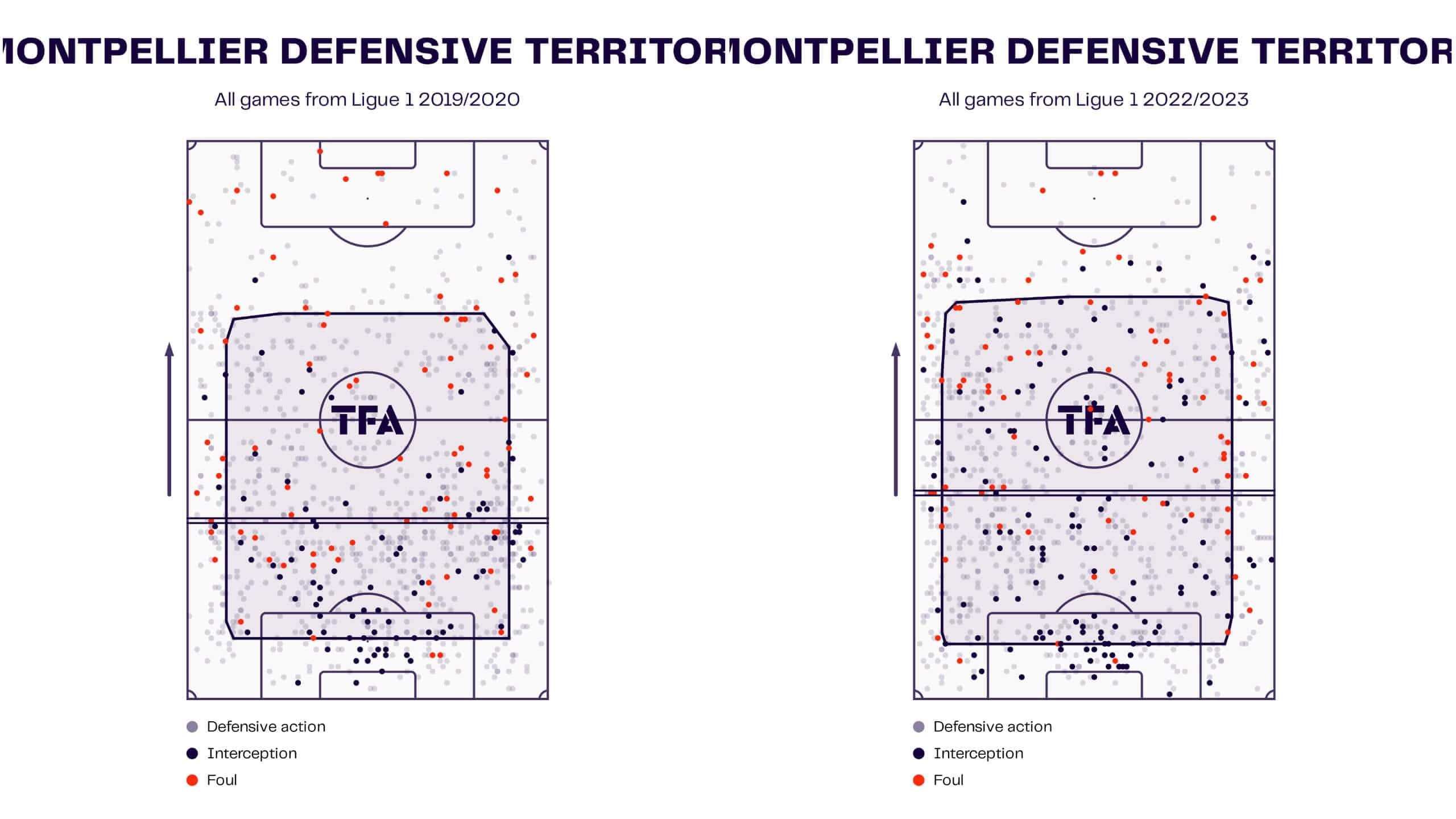
This image further contrasts their defensive style under Der Zakarian and how they’ve defended this season.
We can see that their average defensive line height was significantly deeper in 2019/20 and that there were far fewer defensive actions inside the opposition’s half in 2019/20 compared to this term.
As the season progresses under Der Zakarian, Montpellier should move stylistically closer to the left of the image above and further from the right.
Whether or not that has the desired effect remains to be seen.
Still, the 59-year-old coach undoubtedly showed great ability to organise his defence and generally retain a low xGA during his first tenure at Montpellier, which does give confidence.
Montpellier Ball Progression Problems
Montpellier struggled with ball progression this season.
They’ve made the fewest progressive passes per 90 (56.68) in the league while maintaining the third-lowest progressive pass success percentage (67.9%).
This has contributed to issues with the ball in the final third and, as discussed in the previous section, La Paillade's uninspiring defensive situation.
Michel Der Zakarian Build-up Play
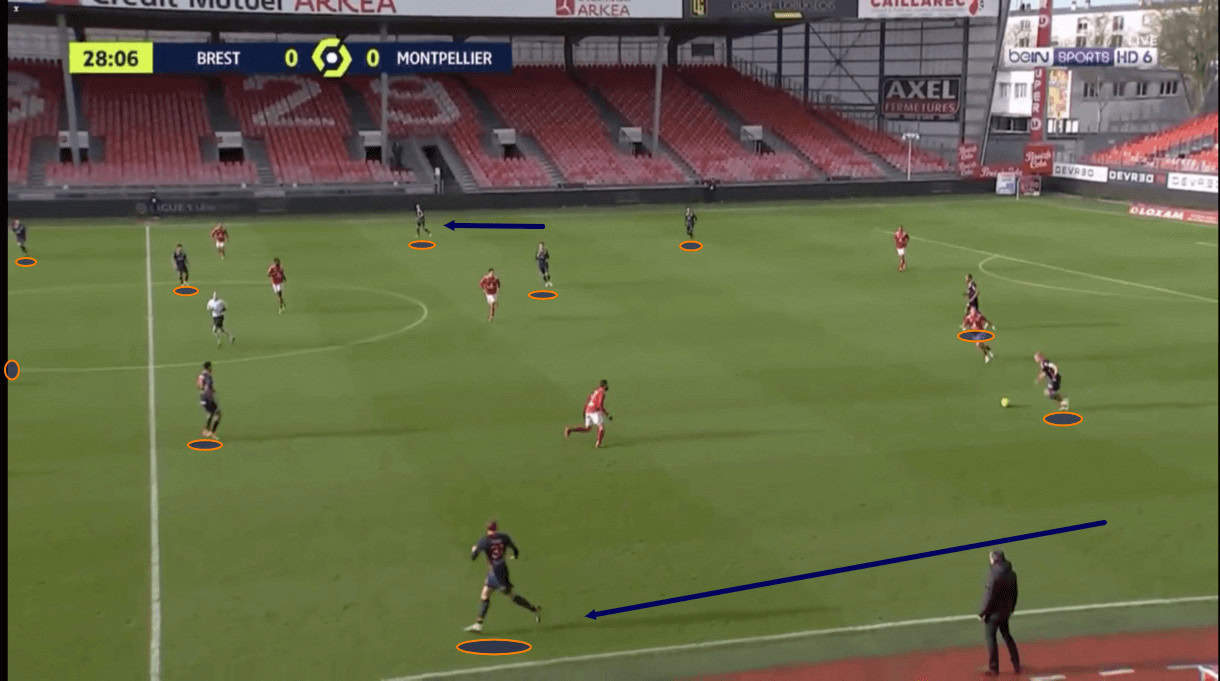
Under Der Zakarian in 2020/21, as seen above, the full-back moved forward on the wing but remained at around a wide midfielder position, looking to act as a link between the first and final third.
The full-back knew his role and positioned himself well to see the pass while being prepared to receive and take the ball forward.
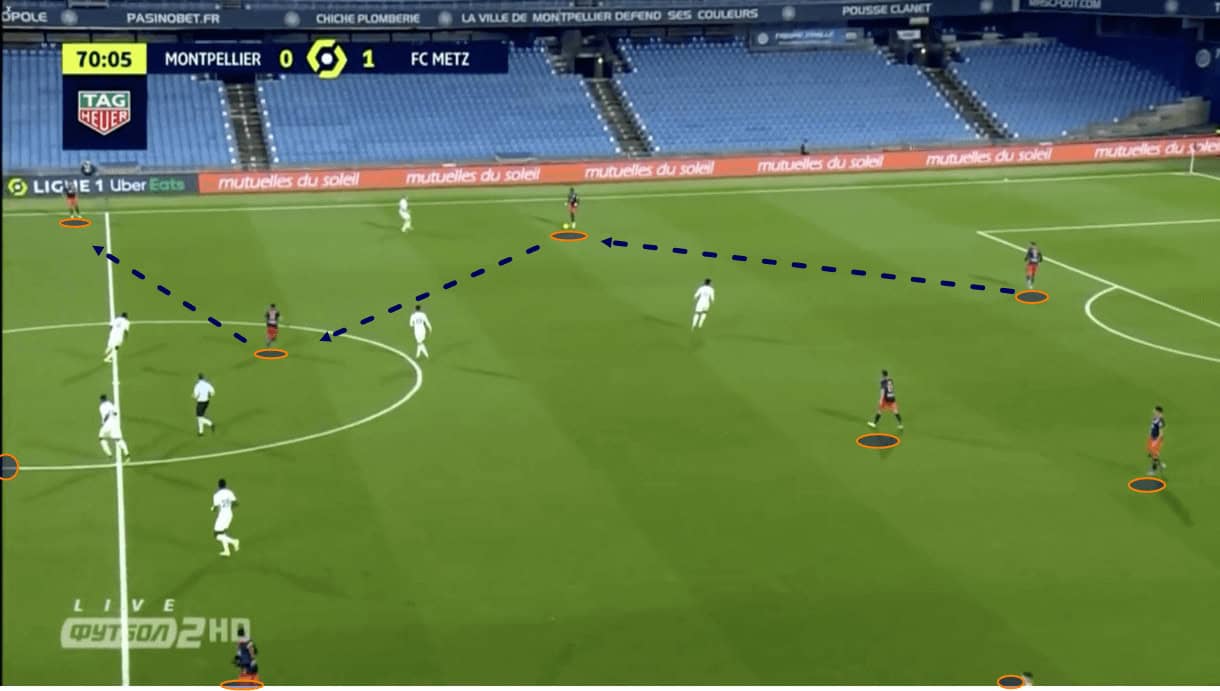
Indeed, they had an offensive role in which they looked to get forward, but primarily, they ensured they didn’t break that link between themselves and the centre-back/goalkeeper.
Primarily, they remained available to them; we saw how this helped Montpellier slice through their opponents in the last image.
The full-back's positioning stretched the opposition, allowing him to use the central midfielder, who could enjoy some space to receive and then quickly play the through ball into the opposition’s half.
Michel Der Zakarian Chance Creation
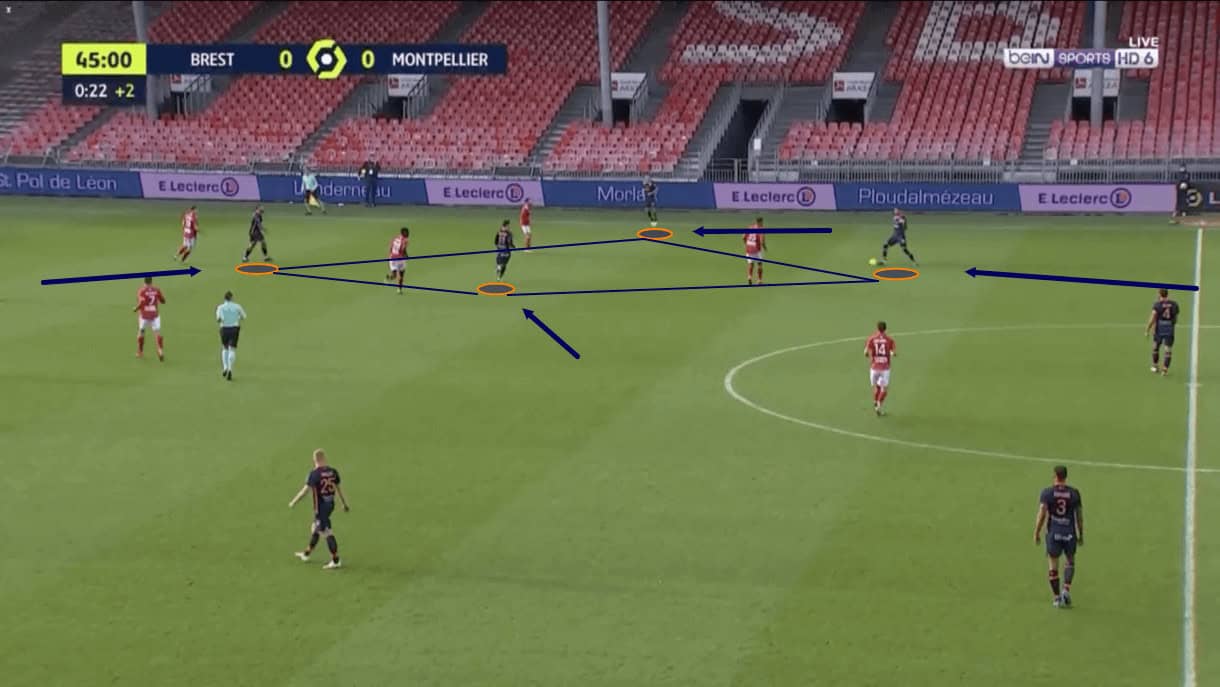
It was common to see the centre forward drop out and become the tip of the diamond in the chance creation phase, as was the case in this example.
Montpellier HSC Build-up Play This Season
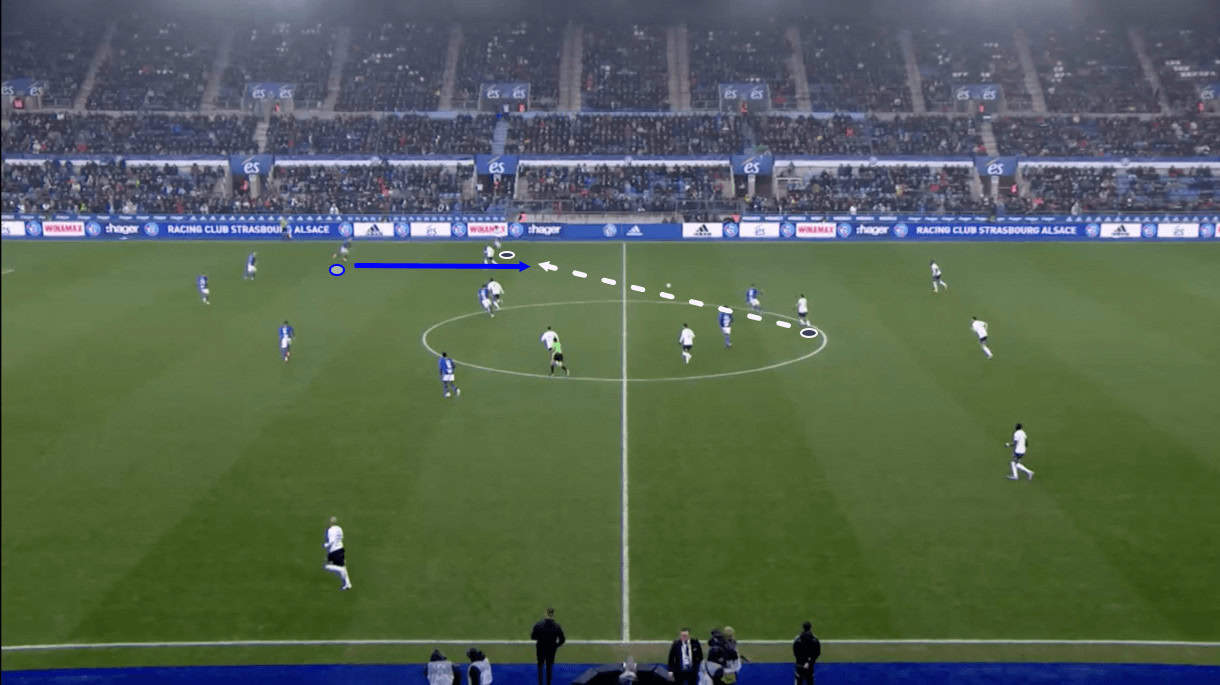
Here, the wide man was running forward but didn’t pay enough attention to the pass coming from midfield; he focused too much on getting forward and not enough on maintaining the link to the deeper player.
As a result, he failed to receive the ball as the opposition intercepted and drove forward to attack Montpellier’s weakened (as a result of the team losing the ball with the full-backs sent forward) backline.
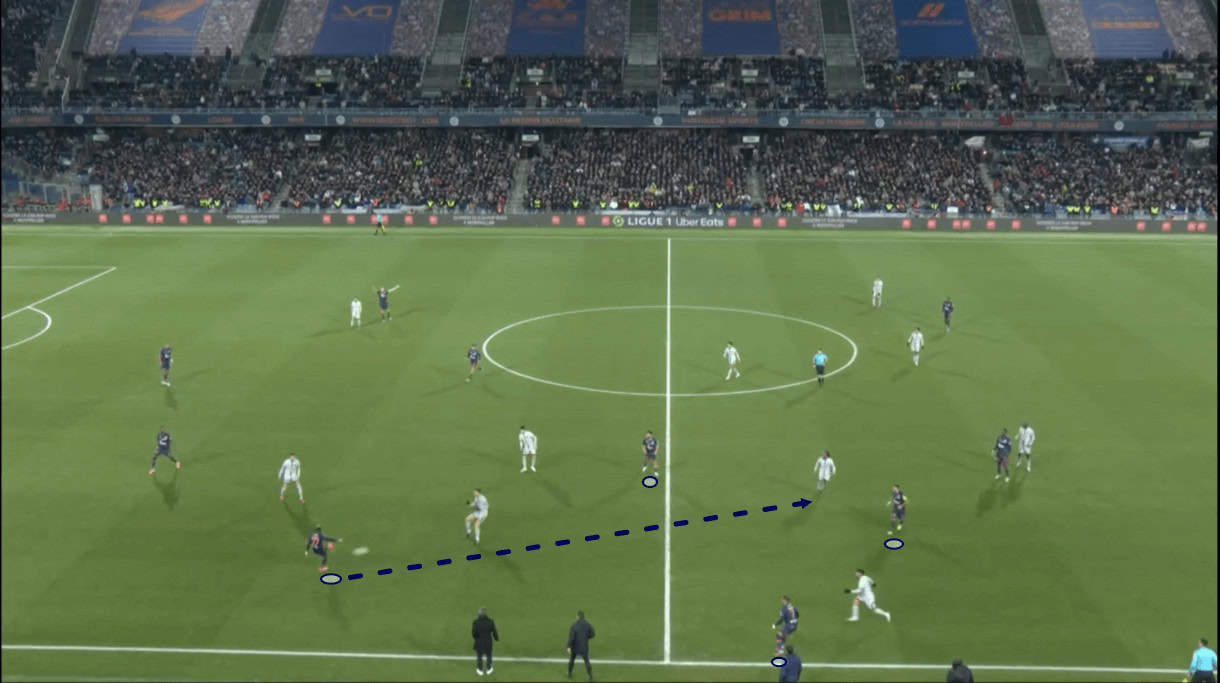
The pass was probably not really on here and even then, the execution was fairly poor, leaving the interception a relatively easy job for the defensive player.
Montpellier Progressive Passes Map: 2022/23 Vs 2020/21
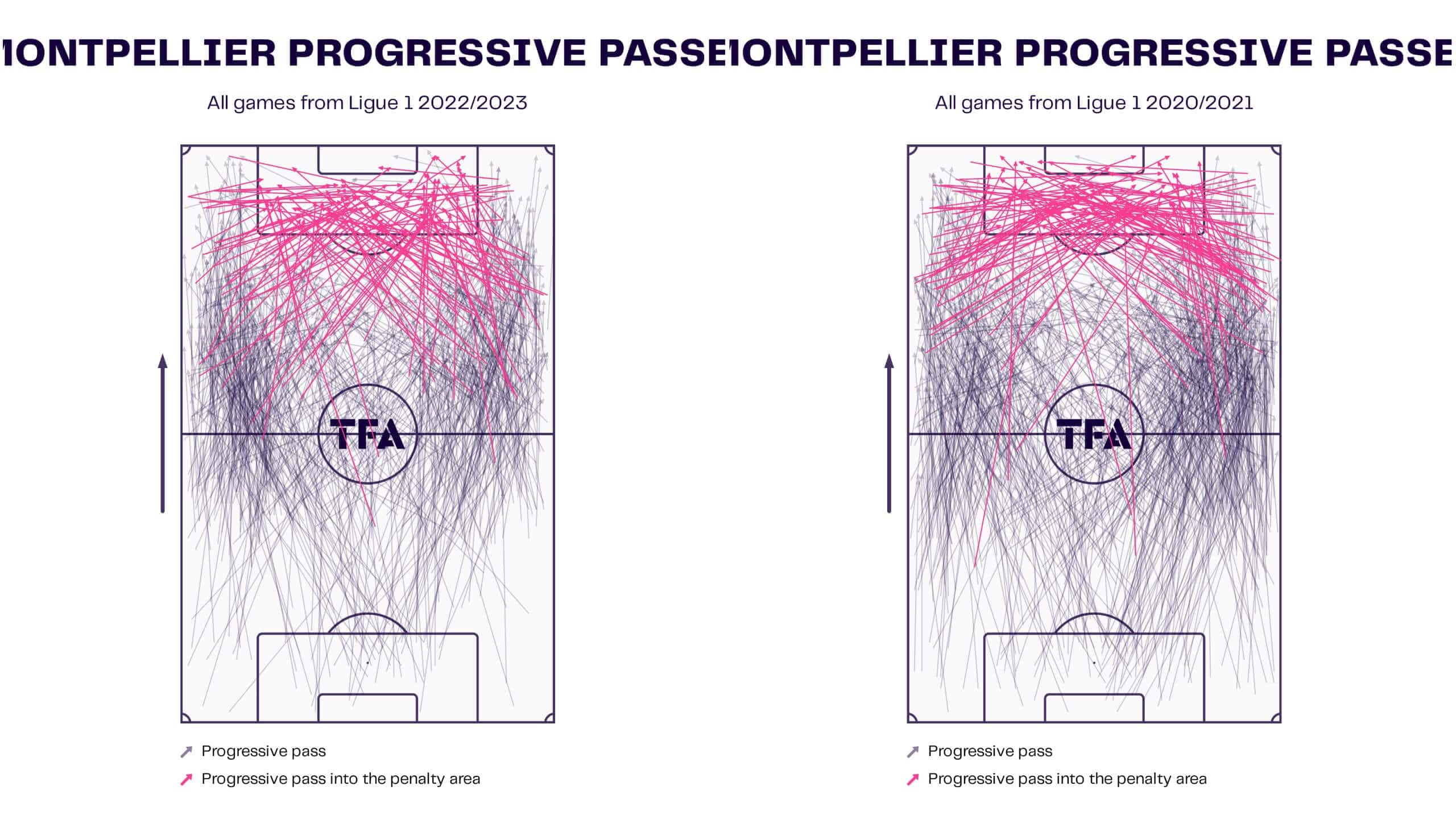
In 2020/21, for example, Der Zakarian’s team played the 10th-most progressive passes per 90 (64.59) in Ligue 1, while holding the eighth-best progressive pass success rate (75.9%).
Both of these numbers present a stark difference to the 2022/23 campaign.
Der Zakarian will aim to iron out the wrinkles in his side’s progressive passing game and end the many sloppy mistakes plaguing La Pallaide’s play in the ball progression phase at present.
One of the more interesting things this figure shows is how Montpellier made far more progressive passes from deep, wide areas in 2020/21, whereas they’ve been few and far between, this season.
Again, this may be a result of the full-backs’ roles switching from connector to all-out attacking outlet
Given how their progressive passing has failed to improve since then, perhaps Der Zakarian will look to revert to how his Montpellier side did things in the past, or at least something more similar to that.
Téji Savanier Progressive Passes Map
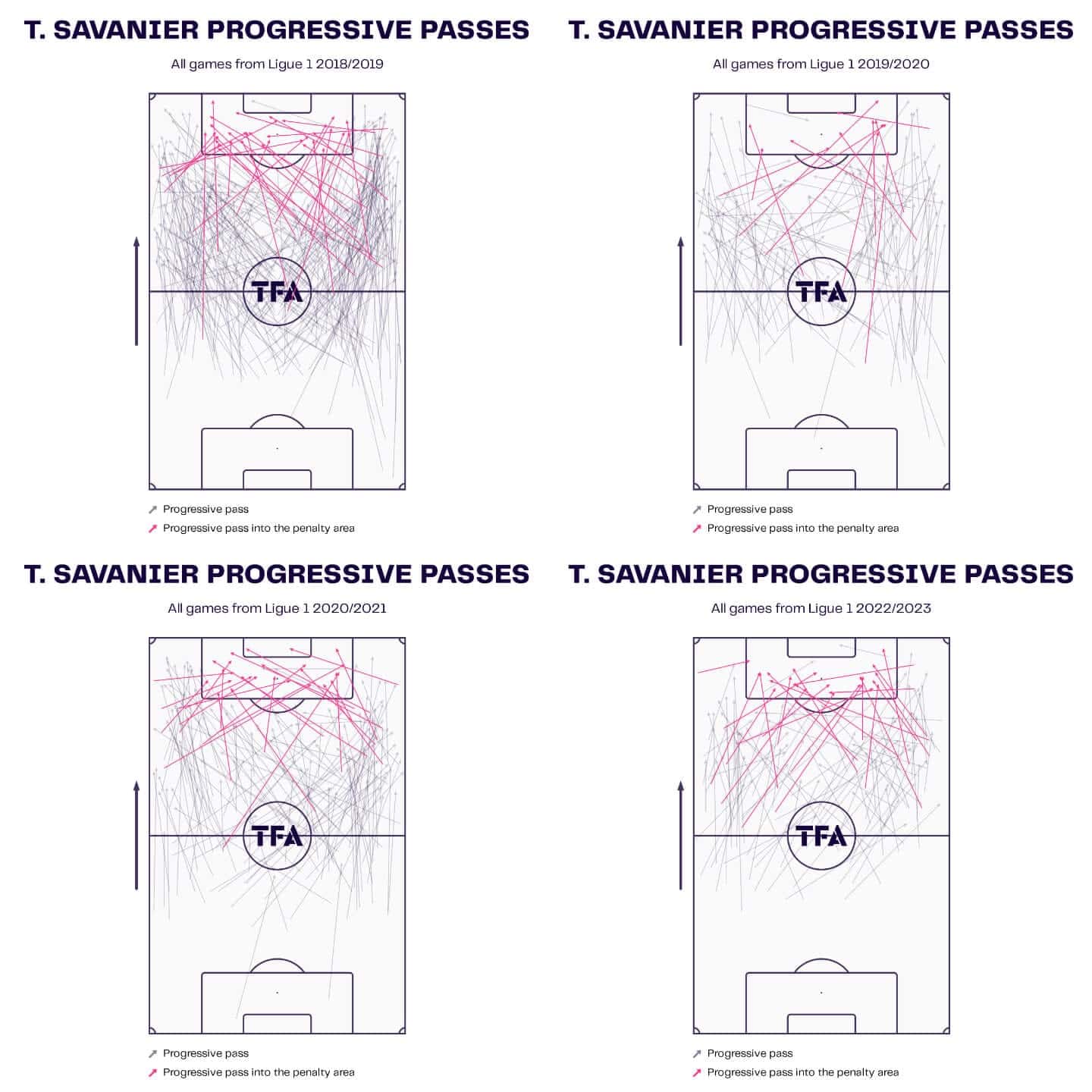
Additionally, key playmaker Téji Savanier typically played a deeper role under Der Zakarian, whereas he’s freer now and typically occupies more advanced positions.
Perhaps Der Zakarian will look to drop Savanier a bit deeper again to help the team with his quality on the ball earlier in possession.
Montpellier Chance Creation Issues
Finally, Montpellier has generally performed quite well in chance creation this season.
La Paillade scored the 11th-most goals in the league (31), and it would appear that Der Zakarian should focus on their defensive deficiencies—which is largely true.
However, Montpellier has generated just 27.51 xG this term — the third-lowest in Ligue 1 — while they’ve generated 0.124 xG per shot — the joint-fourth-lowest in France’s top flight.
These numbers also rank in the area Montpellier doesn’t want to be, so it’ll be far from “keep up the good work!” from Der Zakarian to his team on the offensive front, as there’s plenty of work to be done here.
In 2020/21, Montpellier finished the season with the sixth-highest xG (57.45) and the joint-eighth-highest xG per shot (0.13). Der Zakarian gradually improved the team’s xG per shot over time from 0.091 in 2017/18 — the second-lowest in Ligue 1 that term.
The general standard of xG per shot has improved in Ligue 1 over the last few seasons, and Montpellier’s 0.124 xG per shot puts them among the worst in the league for this particular metric.
Montpellier Crossing Zones Map
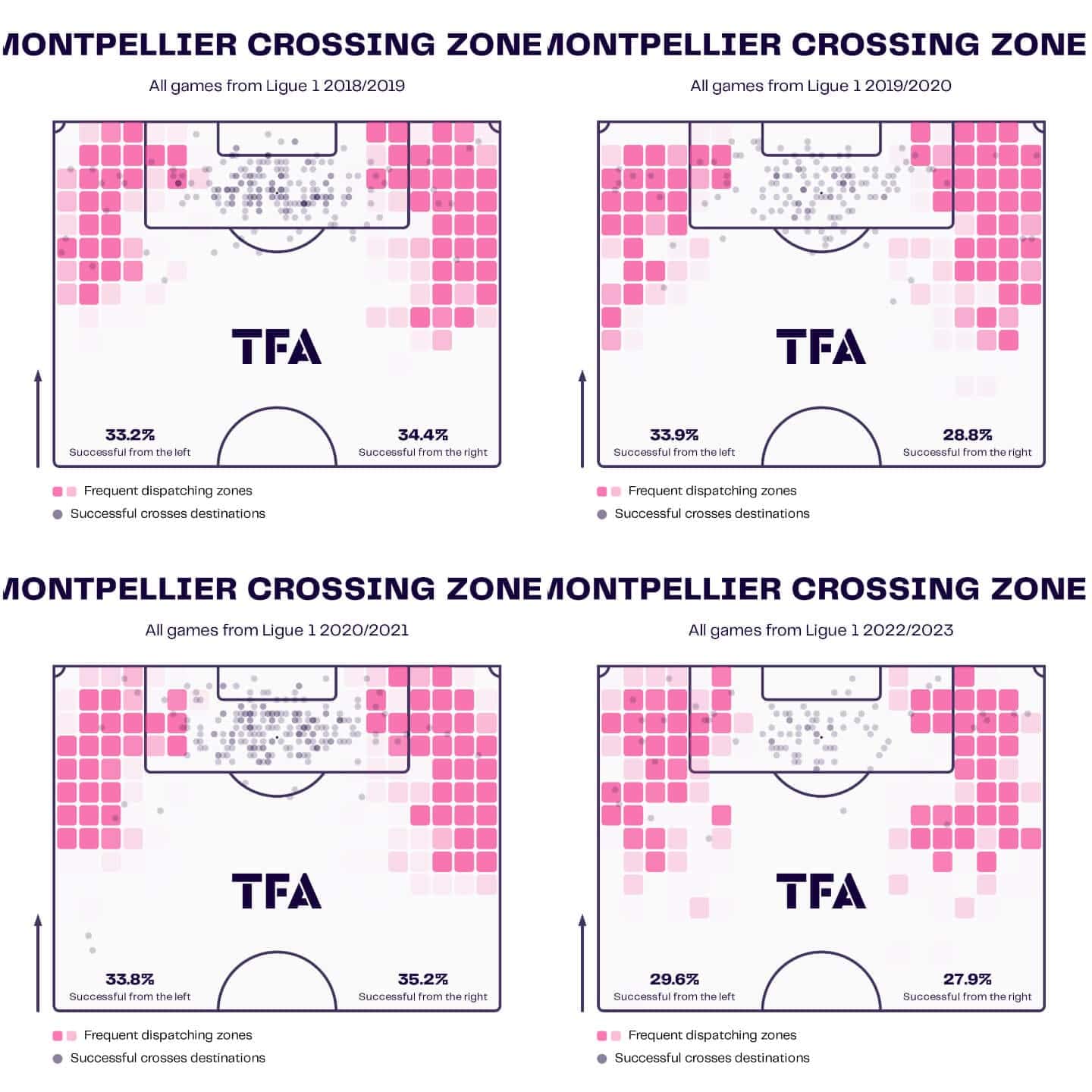
Crossing from deep, wide areas was a significant part of Montpellier’s chance creation under Der Zakarian's first tenure.
The image above shows how crosses from these areas have diminished compared to how frequent they were during Der Zakarian’s tenure and how much less successful La Paillade’s crossing has been lately, compared to Der Zakarian’s first term.
On the 59-year-old’s Montpellier return, we expect the new manager to explore increasing the team’s frequency of crossing from deep, wide areas.
We also expect efforts to drastically improve their crossing success, given how significantly it’s dropped off compared to before and how important this was to Der Zakarian’s team.
So, Der Zakarian is tasked with once again helping this team improve in this area, but as his first tenure showed, it doesn’t happen overnight.
But how can we expect Der Zakarian to influence his new team in the chance creation phase?
The solution might be the young star striker Elye Wahi.
Elye Wahi: The Attack Remedy
Elye Wahi, the 20-year-old star French talent, has already been linked with clubs like Arsenal and their rivals Tottenham.
As we show above, the former Golden Boy nominee maintained a solid 0.2 xG per shot in front of goal this season.
Elye Wahi xG Map
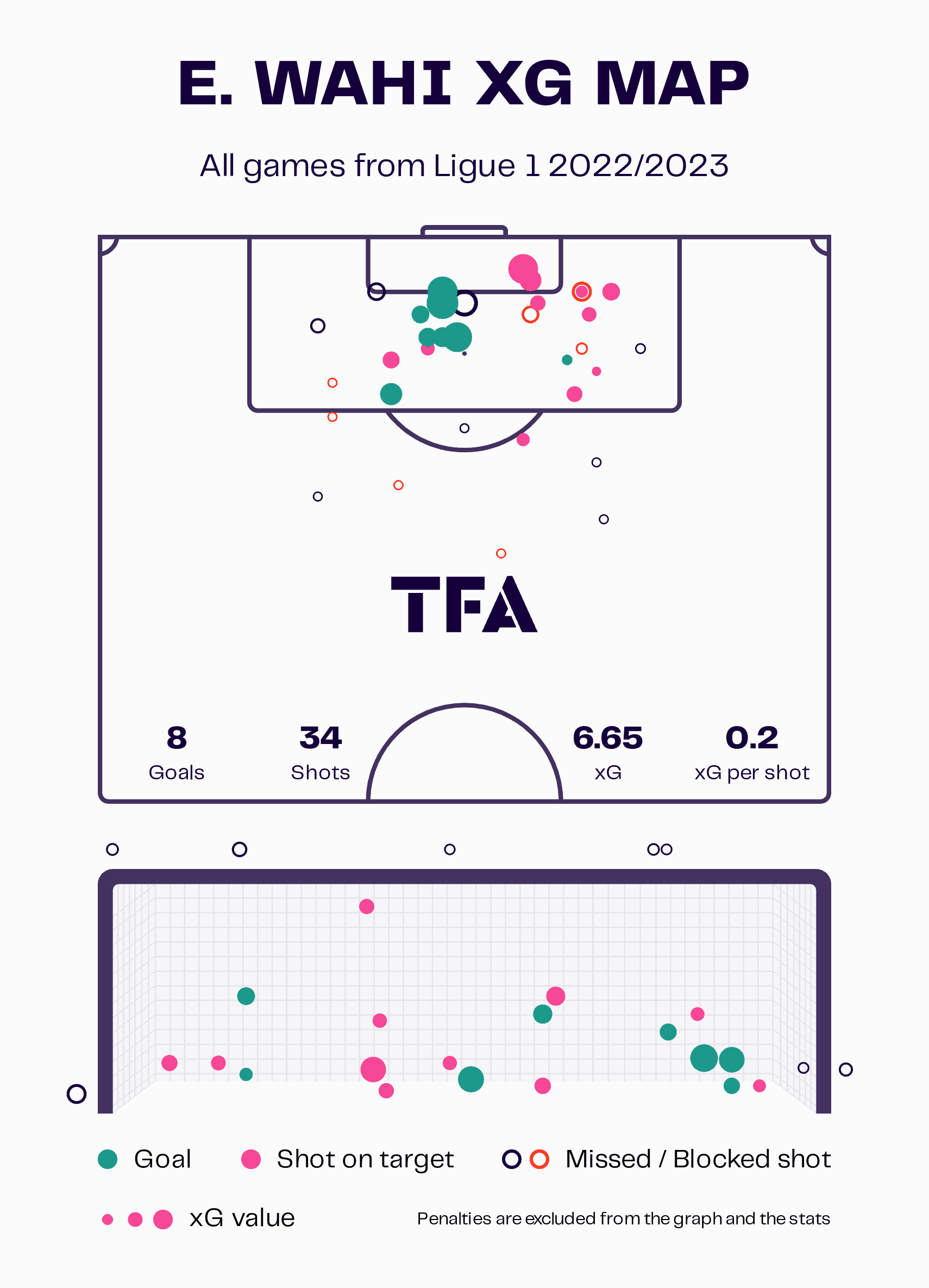
Typically, his movement is an excellent tool for his team in front of goal, as the two-image sequence below shows.
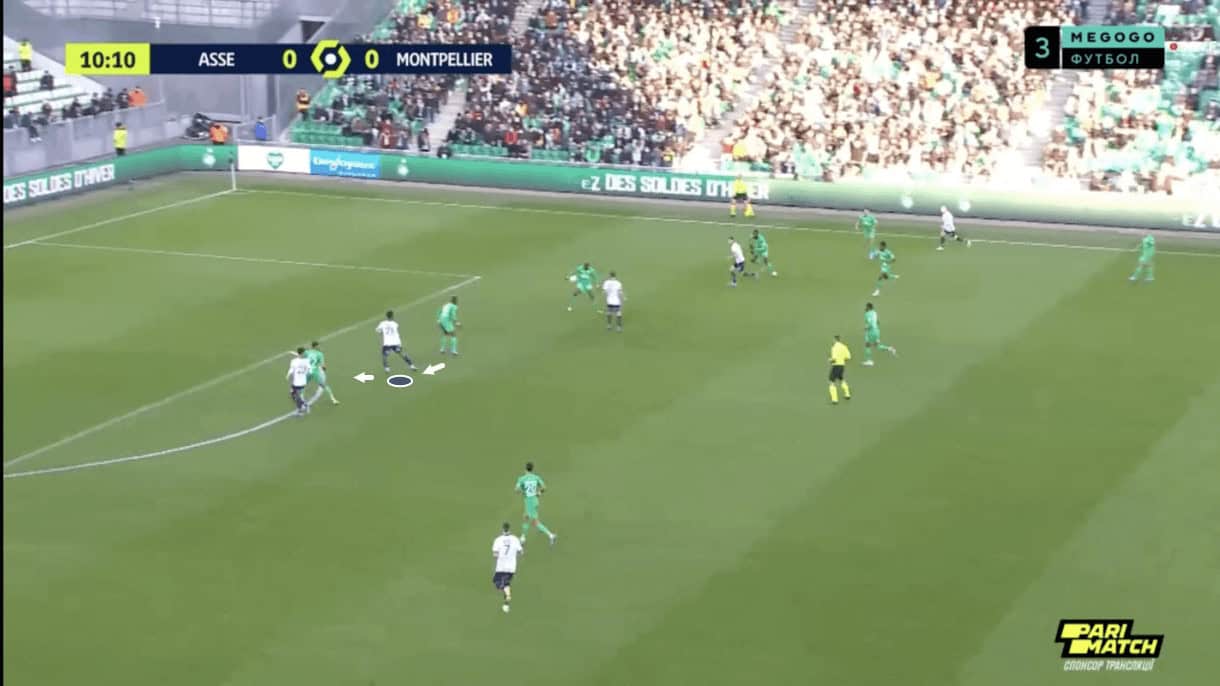
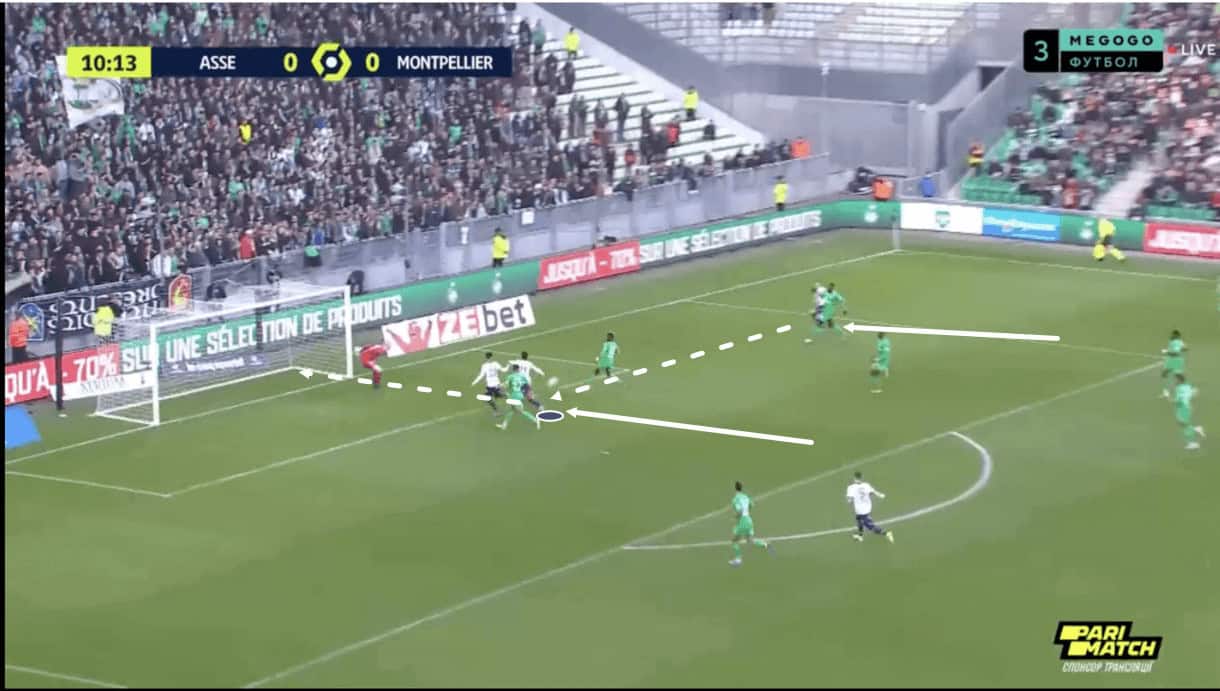
The star striker is typically good at timing his runs and keeping himself onside until the pass is played through to him.
The 20-year-old loves making these types of runs where he can accelerate off the defender’s shoulder and burst into space beyond the opposition’s backline.
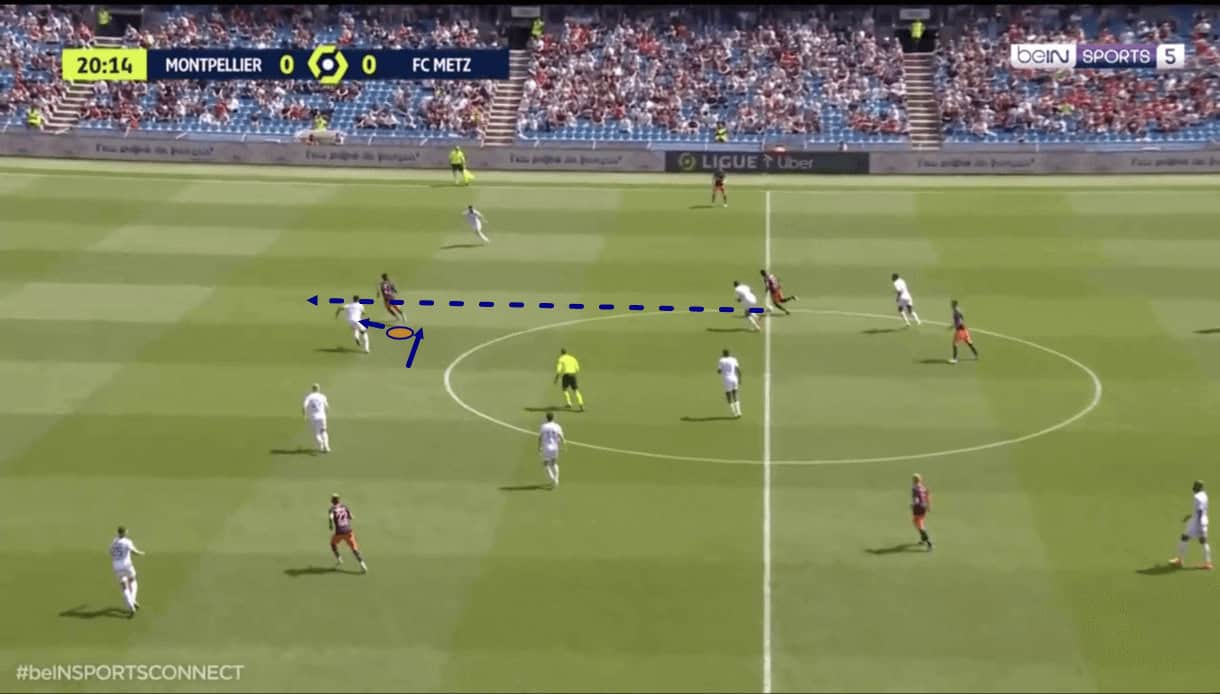
Der Zakarian will likely get his team dropping off more in defensive phases, thus opening up more space behind the opposition’s backline to exploit upon regaining possession.
Suppose he can influence some improvement on the ball progression side of things.
In that case, Montpellier should be able to create more opportunities to find Elye Wahi in behind, targeting this space and the striker’s movement.
Conclusion
It’s clear that Der Zakarian has work to do all across the board.
However, we hope our Montpellier HSC tactical analysis has shown potential ways for the 59-year-old to solve some of La Paillade’s biggest problems based on Michel Der Zakarian's style of play and previously employed tactics.





Comments